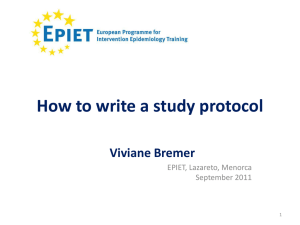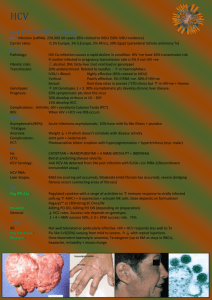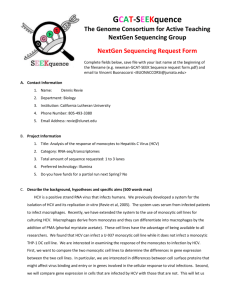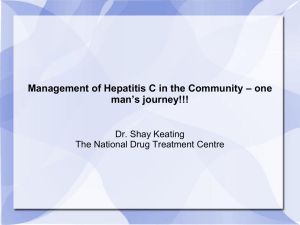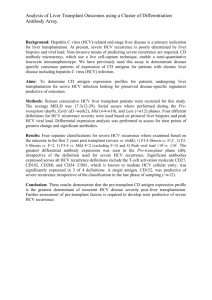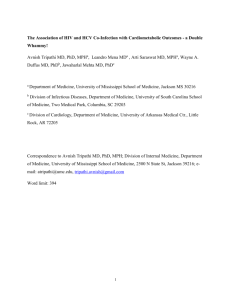Reviewer`s report Title: Molecular epidemiology of a hepatitis C virus
advertisement
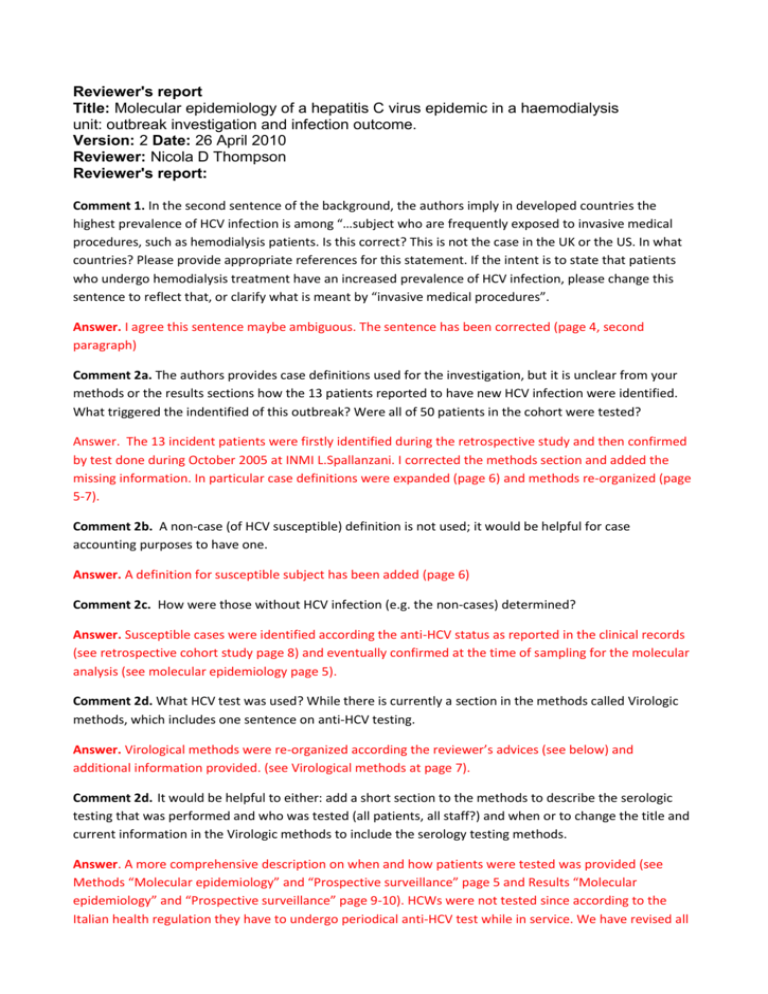
Reviewer's report Title: Molecular epidemiology of a hepatitis C virus epidemic in a haemodialysis unit: outbreak investigation and infection outcome. Version: 2 Date: 26 April 2010 Reviewer: Nicola D Thompson Reviewer's report: Comment 1. In the second sentence of the background, the authors imply in developed countries the highest prevalence of HCV infection is among “…subject who are frequently exposed to invasive medical procedures, such as hemodialysis patients. Is this correct? This is not the case in the UK or the US. In what countries? Please provide appropriate references for this statement. If the intent is to state that patients who undergo hemodialysis treatment have an increased prevalence of HCV infection, please change this sentence to reflect that, or clarify what is meant by “invasive medical procedures”. Answer. I agree this sentence maybe ambiguous. The sentence has been corrected (page 4, second paragraph) Comment 2a. The authors provides case definitions used for the investigation, but it is unclear from your methods or the results sections how the 13 patients reported to have new HCV infection were identified. What triggered the indentified of this outbreak? Were all of 50 patients in the cohort were tested? Answer. The 13 incident patients were firstly identified during the retrospective study and then confirmed by test done during October 2005 at INMI L.Spallanzani. I corrected the methods section and added the missing information. In particular case definitions were expanded (page 6) and methods re-organized (page 5-7). Comment 2b. A non-case (of HCV susceptible) definition is not used; it would be helpful for case accounting purposes to have one. Answer. A definition for susceptible subject has been added (page 6) Comment 2c. How were those without HCV infection (e.g. the non-cases) determined? Answer. Susceptible cases were identified according the anti-HCV status as reported in the clinical records (see retrospective cohort study page 8) and eventually confirmed at the time of sampling for the molecular analysis (see molecular epidemiology page 5). Comment 2d. What HCV test was used? While there is currently a section in the methods called Virologic methods, which includes one sentence on anti-HCV testing. Answer. Virological methods were re-organized according the reviewer’s advices (see below) and additional information provided. (see Virological methods at page 7). Comment 2d. It would be helpful to either: add a short section to the methods to describe the serologic testing that was performed and who was tested (all patients, all staff?) and when or to change the title and current information in the Virologic methods to include the serology testing methods. Answer. A more comprehensive description on when and how patients were tested was provided (see Methods “Molecular epidemiology” and “Prospective surveillance” page 5 and Results “Molecular epidemiology” and “Prospective surveillance” page 9-10). HCWs were not tested since according to the Italian health regulation they have to undergo periodical anti-HCV test while in service. We have revised all these test and found no anti-HCV positive HCW (see methods “Auditing procedure” page 6 top 2 lines and Results “Auditing procedure” page 11 ) Comment 2e. Were all patients tested for the presence of HCV RNA? What about genotype, and molecular analysis. At each stage of testing describe who/what was tested? Answer. All the missing information has been reported (see Methods “Molecular epidemiology” and “Prospective surveillance” page 5 and Results “Molecular epidemiology” and “Prospective surveillance” page 9-10 ). In general of the 50 patients 43 were sampled and testes at INMI while 7 were not since in other HD centers. Comment 3. In order to help the reader understand what patients or sub-set of patients are being referred to, please use the case definitions consistently throughout the manuscript. For example, newly infected patients, incident cases and became anti-HCV positive are all used to describe the group who had newly acquired HCV infection. The term susceptible patients is used, but is not defined in the methods section. Prevalent and chronically infected patients (molecular analysis results paragraph), and chronic HCV carrier (discussion). Answer. All definitions throughout the paper have been homogenized according to the reviewer’s advice. Comment 4. The first paragraph under auditing procedure is a description of what you did. This paragraph belongs in the methods section, not the results. Answer. The passage has been moved from Results to Methods according to the reviewer’s advice. Comment 5. In the methods it states a retrospective cohort study is performed, yet in the results you report odds rations (OR) as the measure of association. The appropriate measure for a cohort study is the Risk Ratio, please can you clarify why odds ratios are reported? Answer. According to the advice of Reviewer 2 the cohort analysis has been re-done using a more appropriate approach (see “Statistical methods” page 7-8 and reference 12). Now association measures are given in rate ratio. Comment 6. Statistical methods: The description of the analysis in the methods includes an assessment of risk factors that include being dialyzed after or along a HCV gen-2 positive subject. What is the relevance of this? This appears to be the use of information that should be in the results section in the methods section. Please re-write this so that results are not used as part of the methods. Answer. The relevance of these are that either from the patients’ clinical records retrospectively taken or from the results of the molecular analysis we found that all incident cases were infected by genotype 2c HCV. Moreover in principle a patient may be at risk either if he/she is dialyzed after or along another infected subject and this depend on the type of lack of infection control measure that may have occurred. Sorry but I cannot clearly understand the second part of the comment. Comment 7. Results. Please move the section called “clinical setting and population at risk” to the beginning of the results section, including the data presented in Table 1. Also, the first paragraph under clinical follow-up on acute HCV infection would also be more informative to the reader if it were included in the first paragraph or two of the results section. Answer. I would rather to keep this section in the methods according to what stated in ORION 2007 guideline. Please see for reference ORION 2007 statement check list item n. 7 and 8 (Stone SP, Cooper BS, Kibbler CC, et al The ORION statement: guidelines for transparent reporting of outbreak reports and intervention studies of nosocomial infection. Lancet Infect Dis. 2007 Apr;7:282-8.). Also Comment 8. Statistical methods and results: The description of the analysis in the methods includes an assessment of risk factors that include being dialyzed after or along a HCV gen-2 positive subject. However, in the 2nd paragraph of the methods section it states, “As reported in table 2, unadjusted analysis evidenced that having been dialyzed at least once either after (p=0.035; OR= 5.50 [1.05-28.88]) or in the same session (p=0.029; OR= 0.21 [0.05-0.89]) of a HCV positive subject …”. In the results, do you mean any HCV positive subject or should this be the HCV gen-2 positive subject, as stated in the methods? Please clarify how these variables were constructed and the data analyzed. Answer. I agree this sentence maybe ambiguous. The sentence has been corrected. I meant only HCV gen 2 subjects. Comment 9. The statistical analysis appears to include all 13 patients with new HCV infection; however, HCV characterization was completed only for 10 or 13, and analysis by HVR1 only for 8 or 13. Here, the assumption is made that the single HCV genotype 2c prevalent case was the source of HCV infection also for those that could not undergo characterization. Do the authors think the 3 patients without HCV characterization are also associated with the same HCV genotype 2c prevalent case? Were these 3 patient seen on April 20th? What epidemiologic data supports that the HVC genotype 2c prevalent case was the likely source of their infection? How common/rare is genotype 2c in Italy and/or this regions? Could other prevalent cases (i.e. the 3 that were not available) have been the source of their infection? Please address this is the discussion (limitations?) section, and the potential for introducing exposure misclassification into the statistical analysis. Answer. “New HCV infection” has been changed in “possible or confirmed cases”. I hypnotize that also the 3 patients without molecular characterization (i.e.: possible case) are likely to be associated to the index cases since they underwent HD on the 20 April and were infected with genotype 2c HCV. Nevertheless as you can see I used 2 different case definitions to distinguish patients with and without molecular characterization of both NS5B and HVR1. In Italy, as other EU countries, genotype 2c is the second most frequent genotype and it is associated with nosocomial transmission (see reference 15).The evidence that the index case was the source of infection is the molecular characterization for the 8 confirmed cases, the the analysis of NS5B of 2 possible case and the fact that all incident case were infected with genotype 2c HCV. The possibility that 3 prevalent cases maybe the source of infection of the 3 non characterized cases cannot be ruled out but it is quite unlikely. I discussed this point in the last paragraph of discussion as a potential limitation (see discussion last paragraph page 14). Comment 10. General organization : It would improve the flow and comprehension of the paper if the order and headings used in methods and results sections mirrored one another. As currently written, the methods section is very difficult to follow and confusing. For example, the case definitions make use of methods information that has not yet been presented (the virologic methods). Answer. General structure of methods and results were revised according to this and previous the reviewer’s advices. Comment 10a. The 33 weeks retrospective analysis – is this the definition of the study period (when you believe transmission most likely occurred? If yes, please state that and why you selected that period. Is this the period used for the data analysis described in the statistical analysis described later on in the methods section? If so, it would be helpful to have these two pieces of information together. Answer. I decided to analyze in the retrospective study 33 weeks it include 24 weeks before the onset of the first case and end of the week preceding the onset of the last case (i.e. the end of the epidemic). Yes this is the period used for the statistical analysis. I specify this on the methods section according to the reviewer’s advice (see Methods “retrospective cohort study” page 5) . Comment 10b. 24 weeks prospective surveillance. Prospective surveillance for what? Are the results of the prospective surveillance reported in the results? Clarify what this means and the relevant findings in the results section. Answer. A detailed description of prospective surveillance is now given in methods section (page 5) and results reporting accordingly at page 10. Comment 10c. The order of the final 3 bullets does not make chronological sense. Suggest placing auditing procedures first, then molecular characterization, and finally 1-year follow-up. Answer. General structure of methods and results was revised. Comment 10d. The section called “Clinical setting and population at risk” is a description of the hemodialysis unit and general operations, and the number of sessions performed during the study period and refers to Table 1 – a description of patients in the facility. By all accounts, this information appears to be results, and would thus be better suited to the results section. Answer. I would keep this section there see answer comment 7. Comment 11. What was the size of the multi-dose heparin vial? Please report this information. How many heparin doses (2ml) were in each vial? Could one heparin vial have been the source for all 11 patients seen in April 20th? In what format/size was the saline that was drawn into a syringe with the heparin? What was format (single dose, multi-dose, or saline bag), and what size was the saline? How was the saline used (for one patient and then discarded, or for multiple patient). Have you considered the possibility that the saline became contaminated and was the vehicle of HCV transmission? See: Macedo de Oliveira, et al. An outbreak of hepatitis C virus infections among outpatients at a hematology/oncology clinic. Ann Intern Med. 2005;142:898-902. Answer. The size of the saline solution used was 250 ml and the heparin vials were of 20 ml. I added this information in the text (see Results “Audit procedures” page 11). The exact way in which the 20 ml heparin doses to be given to the patients went contaminated (please refer to audit result for preparation of heparin) may not completely be elucidate. However I believe suggestion is quite sensible in fact it may be possible that one or more 250 ml saline solution and/or 20ml heparin vials went contaminated in the morning session and then used to prepare the heparin solutions to be given to the patients in the afternoon session (see Discussion page 12). I have already specified that neither saline vials nor saline solution were discarded until exhausted so that always used on more than one patient (see Results “Audit procedures” page 11). Each saline solution and each heparin vials were enough to prepare a maximum of 13 and 10 heparin patients’ doses respectively (see Results “Audit procedures” page 11). Comment 12. Figures 2 and 3 need a descriptive figure legend. For figure 3, what do the percentages at the top of each bar refer to (the % of sessions with a HCV positive patient attending), this should be made clear to the reader. For figure 3, 3 prevalent cases were not genotyped. It would provide a better overall picture of the outbreak if this figure also included the session when these three cases also attended. Could be shown as “HCV positive – unknown genotype”. Answer. According to both reviewers’ suggestion figure 2 and 3 were omitted. Comment 13.Figure 4 requires a descriptive figure legend and key, and additional information to orient the reader to the cases and interpretation. Answer. Case interpretation has been provided. Comment 14.Table 3: the data presented in table 3 is all reported in the manuscript text, and is therefore redundant. Suggest deleting the table, and ensuring all of the content is reported in the text in the appropriate section of the results. Answer. I would keep this table since it gives a concise summary of the overall outcome of the epidemic. (in particular no limit of tables and pictures is given in BMC as it is an online journal) Minor Essential Revisions (MER) MRE 1. Delete final sentence at the end of the first paragraph of the abstract as it duplicates the prior sentence. Answer. The sentence has been deleted. MRE 2. Throughout the manuscript a number of different terms are used for HCV antibody (for example; anti-HCV in the abstract, anti-HCV-Ab in the 2nd paragraph of the background, HCV-Ab in the 1st paragraph of the Epi and Clin definitions, anti-HCV antibody in the 1st paragraph under virological methods). Please standardize the used of this term throughout the manuscript. The standard is to use “HCV antibody (antiHCV)” for its first use, and then to use “anti-HCV” thereafter. Answer. Definitions have been standardized. MRE 3. Under molecular analysis results, please include the HCV genotype for the second HCV prevalent case that underwent genotyping? Answer. It has been added (gen 1b; see page 10 first line)? Discretionary Revisions (DR) DR 1. Figures 2 and 3 are not very informative in their current format and do not add substantially to manuscript. Consider, a) re-working the format so the information is more meaningful to the reader, b) deleting these figures from the manuscript and providing a short explanation in the text of the results. Answer. According to both reviewers’ suggestion figure 2 and 3 were omitted. DR 2. Results. In the first paragraph under clinical follow-up: An increase in ALT is a sign (physical manifestation of illness and not subjective illness experienced by the patient), not a symptom of acute HCV infection. Suggest a change from symptom to sign. Answer. This is quite true and this definition has been revised also according to both reviewers’ suggestion. DR3. Suggest an outline similar to the one below for the order of the methods, an for the reporting result: I. II. III. IV. V. VI. VII. Clinical setting and population at risk (report what your methods not results) Serologic/virologic methods and molecular characterization Case definitions (including non-case) Epidemiological definitions ( Prevalence rate/Attack rate/clinical AR) Retrospective cohort analysis and statistical methods Auditing procedures 1 year clinical follow-up and clinical outcome definition. Answer. The general structure of the methods and results section has been revised.
